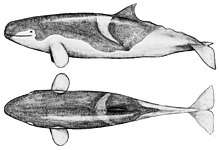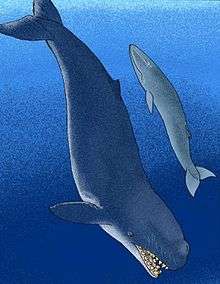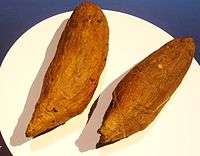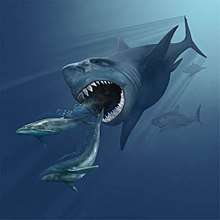Livyatan
| Livyatan | |
|---|---|
 | |
| Cast of skull at the Natural History Museum of the University of Pisa. | |
| Scientific classification | |
| Kingdom: | Animalia |
| Phylum: | Chordata |
| Class: | Mammalia |
| Order: | Artiodactyla |
| Infraorder: | Cetacea |
| Superfamily: | Physeteroidea |
| Family: | incertae sedis |
| Genus: | †Livyatan Lambert et al., 2010 |
| Species: | †L. melvillei |
| Binomial name | |
| Livyatan melvillei (Lambert et al., 2010) | |
| Synonyms[1] | |
| |
Livyatan is an extinct genus of sperm whale containing one species: L. melvillei. Its name was inspired by the biblical sea monster Leviathan, and the author of the book Moby-Dick, Herman Melville, where the antagonist is a large sperm whale. It was found in the Pisco Formation of Peru and lived during the Tortonian stage of the Miocene epoch, about 9.9–8.9 million years ago (mya), however a large tooth from Australia implies that either it or a close relative survived into the Pliocene, around 5 mya. It was a member of a group of hyper-predatory macroraptorial sperm whales (or "raptorial sperm whales") and was likely an apex predator, preying on whales, seals, and so forth. Characteristic of raptorial sperm whales, Livyatan had functional, enamel-coated teeth on the upper and lower jaws, as well as several adaptations for hunting large prey.
Its total length has been estimated to be about 13.5–17.5 m (44–57 ft), similar to the modern sperm whale (Physeter macrocephalus), making it one of the largest predators to have ever existed. The tallest tooth measured 36.2 cm (14.3 in), and is the largest tooth of any known animal, excluding tusks. It is distinguished from the other raptorial sperm whales by the basin on the skull, and how it spans the entire length of the snout. The spermaceti organ, contained in that basin, is thought to have been used in echolocation and communication, or for ramming prey and other sperm whales. The whale may have interacted with the large extinct shark megalodon (Carcharocles megalodon), competing with it for a similar food source. Its extinction was likely caused by a cooling event at the end of the Miocene which resulted in a drop in food populations. The formation where the whale has been found has also preserved a large assemblage of marine life, such as sharks and marine mammals.
Taxonomy
Research history

In November 2008, a partially preserved skull, as well as teeth and the lower jaw, belonging to L. melvillei, the holotype specimen MUSM 1676, were discovered in the coastal desert of Peru in the sediments of the Pisco Formation, 35 km (22 mi) southwest of the city of Ica.[1][2] Klaas Post, a researcher for the Natural History Museum Rotterdam in the Netherlands, stumbled across them on the final day of a field trip.[3][4] The fossils were prepared in Lima, and are now part of the collection of the Museum of Natural History, Lima of National University of San Marcos.[3][5]
The discoverers originally assigned—in July 2010—the English name of the biblical monster, Leviathan, to the whale as Leviathan melvillei. However, the scientific name Leviathan was also the junior synonym for the mastodon (Mammut), so, in August 2010, the authors rectified this situation by coining a new genus name for the whale, Livyatan, from the original Hebrew name of the monster. The species name melvillei is a reference to Herman Melville, author of the book Moby-Dick, which features a gigantic sperm whale as the main antagonist.[4][6] The first Livyatan fossils from Peru were dated to around 13-12 million years ago (mya) in the Serravallian Age of the Miocene, but this was revised to 9.9–8.9 mya in the Tortonian Age of the Miocene.[7]
In 2016 in Beaumaris Bay, Australia, a large sperm whale tooth measuring 30 cm (12 in), specimen NMV P16205, was discovered in Pliocene strata by a local named Murray Orr, and was nicknamed the "Beaumaris sperm whale" or the "giant sperm whale". The tooth was donated to Museums Victoria at Melbourne. Though it has not been given a species designation, the tooth looks similar to those of Livyatan, indicating that it was a close relative. The tooth is dated to around 5 mya,[8][9][10] and so is younger than the Peruvian L. melvillei specimen by around 3 million years.[1]
Phylogeny

Livyatan was part of a fossil stem group of hyper-predatory sperm whales commonly known as macroraptorial sperm whales, or raptorial sperm whales, alongside the extinct whales Brygmophyseter, Acrophyseter, and Zygophyseter. This group is known for having large, functional teeth on both the upper and lower jaws, which were used in capturing large prey; and had an enamel coating. Conversely, the modern sperm whale (Physeter macrocephalus) lacks enamel, teeth in the upper jaw, and the ability to use its teeth to catch prey.[11] Livyatan belongs to a different lineage to the other raptorial sperm whales, and the size increase and the development of the spermaceti organ, an organ that is characteristic of sperm whales, are thought to have evolved independently from other raptorial sperm whales. The large teeth of the raptorial sperm whales either evolved once in the group with a basilosaurid-like common ancestor, or independently in Livyatan. The large temporal fossa in the skull of raptorial sperm whales is thought to a plesiomorphic feature, that is, a trait inherited from a common ancestor. Since the teeth of fetal modern sperm whales (Physeter macrocephalus) have enamel on them before being coated with cementum, it is thought that the enamel is also an ancient characteristic (basal). The appearance of raptorial sperm whales in the fossil record coincides with the diversification of baleen whales in the Miocene, implying that they evolved specifically to exploit baleen whales.[1][7] It has also been suggested that the raptorial sperm whales should be placed into the subfamily Hoplocetinae, alongside the genera Diaphorocetus, Idiorophus, Scaldicetus, and Hoplocetus, which are known from the Miocene to the lower Pliocene. However, most of these taxa remain too fragmentary or have been used as wastebasket taxa for non-diagnostic material of stem physeteroids. This subfamily is characterized by their robust and enamel-coated teeth.[12]
|
| ||||||||||||||||||||||||||||||||||||||||||||||||||||||||||||||||||||||||||||||||||||||||||||||||||||||||||||
| Relationships between Livyatan and other sperm whales, raptorial sperm whales in bold[1][7][11] |
Description

Since only the skull of Livyatan is known, the ratio of the skull compared to the rest of the body length is unknown, and so its total body length is unclear. The total length of adult Livyatan is estimated to have been about 13.5 m (44 ft) when using the modern sperm whale for scaling, and 16.2–17.5 m (53–57 ft) when using the raptorial Zygophyseter for scaling; scaling achieved by measuring the head-to-body ratios.[1] In comparison, the modern sperm whale measures on average 11 to 16 m (36 to 52 ft). It has been estimated to weigh 57 tonnes (63 short tons) based on the length estimate of 17.5 m (57 ft).[13] The large size was probably an anti-predator adaptation, and allowed it to feed on larger prey. Livyatan is the largest fossil sperm whale discovered, and was also one of the biggest known predators, having the largest bite of any tetrapod.[1][7]

Skull
The holotype skull of Livyatan was about 3 m (9.8 ft) long. Like other raptorial sperm whales, Livyatan had a wide gap in between the temporal fossae on the sides of the skull and the zygomatic processes on the front of the skull, indicating a large space for holding strong temporal muscles, which are the most powerful muscles between the skull and the jaw. The snout was robust, thick, and relatively short, which allowed it to clamp down harder and better handle struggling prey. The left and right premaxillae on the snout probably did not intersect at the tip of the snout, though the premaxillae took up most of the front end of the snout. Unlike in the modern sperm whale, the premaxillae reached the sides of the snout. The upper jaw was thick, especially midway through the snout. The snout was asymmetrical, with the right maxilla in the upper jaw becoming slightly convex towards the back of the snout, and the left maxilla becoming slightly concave towards the back of the snout. The vomer reached the tip of the snout, and was slightly concave, decreasing in thickness from the back to the front. A sudden thickening in the middle-left side of the vomer may indicate the location of the nose plug muscles. Each mandible in the lower jaw was higher than it was wide, with a larger gap in between the two than in the modern sperm whale. The mandibular symphysis which connects the two halves of the mandibles in the middle of the lower jaw was unfused. The condyloid process, which connects the lower jaw to the skull, was located near the bottom of the mandible like other sperm whales.[1][7]
Teeth

Unlike the modern sperm whale, Livyatan had functional teeth in both jaws. The wearing on the teeth indicates that the teeth sheared past each other while biting down, meaning it could bite off large portions of flesh from its prey. Also, the teeth were deeply embedded into the gums and could interlock, which were adaptations to holding struggling prey. None of the teeth of the holotype were complete, and none of the back teeth were well-preserved. The lower jaw contained 22 teeth, and the upper jaw contained 18 teeth. Unlike other sperm whales with functional teeth in the upper jaw, none of the tooth roots were entirely present in the premaxilla portion of the snout, being at least partially in the maxilla. Consequently, its tooth count was lower than those sperm whales, and, aside from the modern dwarf (Kogia sima) and pygmy (K. breviceps) sperm whales, it had the lowest tooth count in the lower jaw of any sperm whale.[1][7]
The most robust teeth in Livyatan were the fourth, fifth, and sixth teeth in each side of the jaw. The well-preserved teeth all had a height greater than 31 cm (12 in), and the largest teeth of the holotype were the second and third on the left lower jaw, which were calculated to be around 36.2 cm (14.3 in) high. The first right tooth was the smallest at around 31.5 cm (12.4 in).[1][7] The Beaumaris sperm whale tooth measured around 30 cm (12 in) in length, and is the largest fossil tooth discovered in Australia.[9][10] These teeth are thought to be among the largest of any known animal, excluding tusks;[1][7]. Some of the lower teeth have been shown to contain a facet for when the jaws close, which may have been used to properly fit the largest teeth inside the jaw. In the front teeth, the tooth diameter decreased towards the base. This was the opposite for the back teeth, and the biggest diameters for these teeth were around 11.1 cm (4.4 in) in the lower jaw. All teeth featured a rapid shortening of the diameter towards the tip of the tooth, which were probably in part due to wearing throughout their lifetimes. The curvature of the teeth decreased from front to back, and the lower teeth were more curved at the tips than the upper teeth. The front teeth projected forward at a 45° angle, and, like in other sperm whales, cementum was probably continually added onto the teeth throughout its lifetime.[1][7]
All tooth sockets were cylindrical and single-rooted. The tooth sockets increased in size from the first to the fourth and then decreased, the fourth being the largest at around 197 mm (7.8 in) in diameter in the upper jaws, which is the largest of any known whale species. The tooth sockets were smaller in the lower jaw than they were in the upper jaw, and they were circular in shape, except for the front sockets which were more ovular.[1][7]
Basin
The fossil skull of Livyatan had a curved basin, known as the supracranial basin, which was deep and wide. Unlike other raptorial sperm whales, but much like in the modern sperm whale, the basin spanned the entire length of the snout, causing the entire skull to be concave on the top rather than creating a snout as seen in Zygophyseter and Acrophyseter. The supracranial basin was the deepest and widest over the braincase, and, unlike other raptorial sperm whales, it did not overhang the eye socket. It was defined by high walls on the sides. The antorbital notches, which are usually slit-like notches on the sides of the skull right before the snout, were inside the basin. A slanting crest on the temporal fossa directed towards the back of the skull separated the snout from the rest of the skull, and was defined by a groove starting at the antorbital processes on the cheekbones. The basin had two foramina in the front, as opposed to the modern sperm whale which has one foramen on the maxilla, and to the modern dwarf and pygmy sperm whales which have several in the basin. The suture in the basin between the maxilla and the forehead had an interlocking pattern.[7]
Paleobiology

Hunting
Livyatan was an apex predator, and probably had a profound impact on the structuring of Miocene marine communities. Using its large and deeply rooted teeth, it is likely to have hunted large prey near the surface, its diet probably consisting mainly of medium-sized baleen whales ranging from 7–10 m (20–30 ft) in length. It probably also preyed upon sharks, seals, dolphins, and other large marine vertebrates, occupying a niche similar to the modern killer whale (Orcinus orca). It was contemporaneous with and occupied the same region as the megalodon shark, which was likely also an apex predator, implying competition over their similar food source.[1][3][4][14] It is assumed that the hunting tactics of Livyatan for hunting whales were similar to that of the modern killer whale, pursuing prey to wear it out, and then drowning it.[1][15] Modern killer whales work in groups to isolate and kill whales, but, given its size, Livyatan may have been able to hunt alone.[16]
Spermaceti organ
.svg.png)
The supracranial basin in its head suggests that Livyatan had a large spermaceti organ, a series of oil and wax reservoirs separated by connective tissue. The uses for the spermaceti organ in Livyatan are unknown. Much like in the modern sperm whale, it could have been used in the process of biosonar to generate sound for locating prey. It is possible that it was also used as a means of acoustic displays, such as for communication purposes between individuals. It may have been used for acoustic stunning, which would have caused the bodily functions of a target animal to shut down from exposure to the intense sounds.[1][3][7]
Another theory says that the enlarged forehead caused by the presence of the spermaceti organ is used in all sperm whales between males fighting for females during mating season by head-butting each other, including Livyatan and the modern sperm whale. It may have also been used to ram into prey; if this is the case, in support of this, there have been two reports of modern sperm whales attacking whaling vessels by ramming into them, and the organ is disproportionally larger in male modern sperm whales.[1][3][7]
An alternate theory is that sperm whales, including Livyatan, can alter the temperature of the wax in the organ to aid in buoyancy. Lowering the temperature increases the density to have it act as a weight for deep-sea diving, and raising the temperature decreases the density to have it pull the whale to the surface.[1][3][7]
Palaeoecology

Livyatan is known from the Tortonian stage of the Upper Miocene 9.9–8.9 mya in the Pisco Formation of Peru, which is known for its well-preserved assemblage of marine vertebrates. Among the baleen whales found, the most common was an undescribed species of cetotheriid whale measuring around 5 to 8 m (16 to 26 ft), and most of the other baleen whales found were roughly the same size. Toothed whale remains found consist of beaked whales (such as Messapicetus gregarius), ancient pontoporiids (such as Brachydelphis mazeasi), oceanic dolphins, and the raptorial sperm whale Acrophyseter. All seal remains found represent the earless seals. Also found were large sea turtles such as Pacifichelys urbinai, which points to the development of seagrasses in this area. Partial bones of crocodiles were discovered. Of the seabirds, fragmentary bones of cormorants and petrels were discovered, as well as two species of boobies. The remains of many cartilaginous fish were discovered in this formation, including more than 3500 shark teeth, which mainly belonged to the ground sharks, such as requiem sharks and hammerhead sharks. To a lesser extent, mackerel sharks were also found, such as white sharks, sand sharks, and Otodontidae. Many shark teeth were associated with the extinct broad-tooth mako (Cosmopolitodus/Carcharodon hastalis) and Megalodon, and the teeth of these two sharks were found near whale and seal remains. Eagle rays, sawfish, and angelsharks were other cartilaginous fish found. Most of the bony fish findings belonged to tunas and croakers. Livyatan and Megalodon were likely the apex predators of this area during this time.[14][17]
The Beaumaris sperm whale was found in the Beaumaris Bay Black Rock Sandstone Formation in Australia near the city of Melbourne, dating to 5 mya in the Pliocene. Beaumaris Bay is one of the most productive marine fossil sites in Australia for marine megafauna. Shark teeth belonging to twenty different species have been discovered there, such as from the whale shark (Rhincodon typus), the Port Jackson shark (Heterodontus portusjacksoni), the broad-toothed mako, and Megalodon. Some examples of whales found include the ancient humpback whale Megaptera miocaena, the dolphin Steno cudmorei, and the sperm whale Physetodon baileyi. Other large marine animals found include ancient elephant seals, dugongs, sea turtles, ancient penguins such as Pseudaptenodytes, the extinct albatross Diomedea thyridata, and the extinct toothed seabirds of the genus Pelagornis.[18][19][20][21]
A cooling event at the end of the Miocene, which caused baleen whales to increase in size and decrease in diversity, may have been the cause of the extinction, with Livyatan becoming coextinct with the small baleen whales it fed on.[1][3][4][5]
References
- 1 2 3 4 5 6 7 8 9 10 11 12 13 14 15 16 17 18 19 20 21 22 Lambert, Olivier; Bianucci, Giovanni; Post, Klaas; de Muizon, Christian; Salas-Gismondi, Rodolfo; Urbina, Mario; Reumer, Jelle (2010). "The giant bite of a new raptorial sperm whale from the Miocene epoch of Peru" (PDF). Nature. 466 (7302): 105–108. Bibcode:2010Natur.466..105L. doi:10.1038/nature09067. PMID 20596020.
- ↑ Livyatan melvillei at fossilworks.org (retrieved 12 November 2017)
- 1 2 3 4 5 6 7 Fang, Janet (30 June 2010). "Call me Leviathan melvillei". Nature News. doi:10.1038/news.2010.322.
- 1 2 3 4 Ghosh, Pallab (30 June 2010). "'Sea monster' whale fossil unearthed". BBC News. Retrieved 2 July 2010.
- 1 2 Sample, Ian (30 June 2010). "Fossil sperm whale with huge teeth found in Peruvian desert". The Guardian. Retrieved 2 July 2010.
- ↑ Lambert, Olivier; Bianucci, Giovanni; Post, Klaas; de Muizon, Christian; Salas-Gismondi, Rodolfo; Urbina, Mario; Reumer, Jelle (2010). "Corrigendum: the giant bite of a new raptorial sperm whale from the Miocene epoch of Peru". Nature. 466 (1134): 105–108. Bibcode:2010Natur.466.1134L. doi:10.1038/nature09381.
- 1 2 3 4 5 6 7 8 9 10 11 12 13 14 Lambert, O.; Bianucci, G.; de Muizon, C. (2017). "Macroraptorial Sperm Whales (Cetacea, Odontoceti, Physeteroidea) from the Miocene of Peru". Zoological Journal of the Linnean Society. 179: 404–474. doi:10.1111/zoj.12456.
- ↑ Jeffrey, Andy (2016). "Giant killer sperm whales once cruised Australia's waters (and we have a massive tooth to prove it)". Earth Touch News Network. Retrieved 31 May 2016.
- 1 2 "Huge Tooth Reveals Prehistoric Moby Dick in Melbourne". Australasian Science Magazine. Retrieved 24 April 2016.
- 1 2 McSweeney, F.; Buckeridge, J. (2017). The Fossils of the Urban Sanctuary (PDF). Cheltenham, Victoria, Australia: Greypath Productions. p. 62. ISBN 978-1-76056-338-7.
- 1 2 Berta, A. (2017). The Rise of Marine Mammals: 50 Million Years of Evolution. Baltimore, Maryland: Johns Hopkins University Press. pp. 112–113. ISBN 978-1-4214-2326-5.
- ↑ Toscano, A.; Abad, M.; Ruiz, F.; Muñiz, F.; Álvarez, G.; García, E.; Caro, J. A. (2013). "Nuevos Restos de Scaldicetus (Cetacea, Odontoceti, Physeteridae) del Mioceno Superior, Sector Occidental de la Cuenca del Guadalquivir (Sur de España)" [New Remains of Scaldicetus (Cetacea, Odontoceti, Physeteridae) from the Upper Miocene, Western Sector of the Guadalquivir Basin]. Revista Mexicana de Ciencias Geológicas (in Spanish). 30 (2).
- ↑ Villafaña, J. A.; Rivadeneira, M. M. (2014). "Rise and fall in diversity of Neogene marine vertebrates on the temperate Pacific coast of South America". Paleobiology. 40 (4): 659–674. doi:10.1666/13069.
- 1 2 Bianucci, G.; Di Celma, C.; Landini, W.; Post, K.; Tinelli, C.; de Muizon, C. (2015). "Distribution of fossil marine vertebrates in Cerro Colorado, the type locality of the giant raptorial sperm whale Livyatan melvillei (Miocene, Pisco Formation, Peru)". Journal of Maps. 12 (3): 543. doi:10.1080/17445647.2015.1048315.
- ↑ Pitman, R. L.; Ballance, L. T.; Mesnick, S. I.; Chivers, S. J. (2001). "Killer Whale Predation on Sperm Whales: Observations and Implications". Marine Mammal Science. 17 (3): 494–507. doi:10.1111/j.1748-7692.2001.tb01000.x.
- ↑ "New Leviathan Whale Was Prehistoric "Jaws"?". National Geographic. 30 June 2010. Retrieved 3 July 2010.
- ↑ Parham, J. F.; Pyenson, N. D. (2010). "New sea turtle from the Miocene of Peru and iterative evolution of feeding ecomorphologies since the Cretaceous" (PDF). Journal of Paleontology. 84 (2): 231–247. doi:10.1666/09-077R.1.
- ↑ "Beaumaris Bay Fossil Site, Beach Rd, Beaumaris, VIC, Australia". Australian Heritage Database. Retrieved 24 November 2017.
- ↑ Smith, B. (2012). "Trove of ancient secrets submerged under the sea". The Age. Retrieved 24 November 2017.
- ↑ Long, J. (2015). "We need to protect the fossil heritage on our doorstep". The Conversation. Retrieved 24 November 2017.
- ↑ "Beaumaris (Miocene of Australia)". fossilworks.org. Retrieved 25 November 2017.
External links
| Wikispecies has information related to L. melvillei |
| Wikimedia Commons has media related to L. melvillei. |
- 'Sea monster' fossil found in Peru desert by CNN
- Ancient sperm whale's giant head uncovered from Los Angeles Times (The skull is on display in National History Museum in Lima)
- A killer sperm whale with details on sperm whale evolution
- Videos
- The Worlds Largest BITE on YouTube
- The jaws of the Leviathan on YouTube
- Leviathan melvillei on YouTube (a collection of images of discovery)